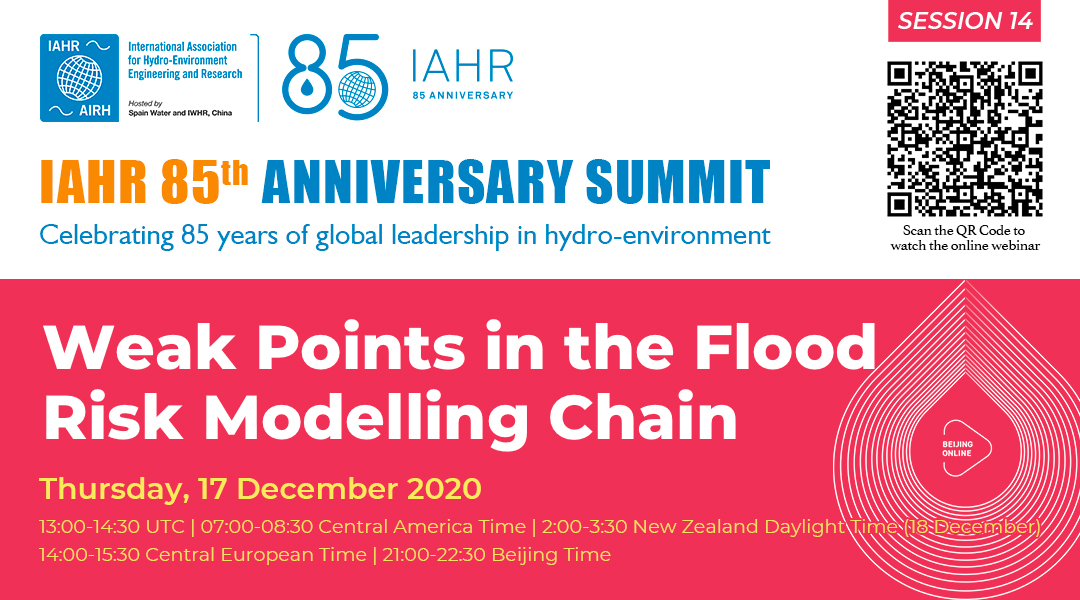

Weak Points in the Flood Risk Modelling Chain

13:00-14:30 UTC | 07:00-08:30 Central America Time (UTC-6) | 2:00-3:30 (18 December) New Zealand Daylight Time (UTC+13) | 14:00-15:30 Central European Time (UTC+1) | 21:00-22:30 Beijing Time (UTC+8)
Thursday, 17 December 2020
In terms of human suffering, economic costs and damage to cultural and environmental heritage, inland and coastal floods have impacts increasing yearly worldwide. This must mean that we are far from properly predicting and managing flood risk. On the one hand, we are faced by the occurrence of more extreme climate-related events, transformations of rural landscapes and unsustainable urban population growth, which continuously changes the boundary conditions at which flood risk models must be adapted to deliver reliable results. On the other hand, our efforts are frustrated by limitations in our modelling capabilities. Both reasons lead to the introduction of a significant uncertainty in flood risk estimation. As a consequence, flood risk management is clearly a demanding job, in practice often leading to inefficient solutions.
In response to these problems, the Flood Risk Management Technical Committee (FRM-TC) of the IAHR is launching an initiative on “Weak Points in the Flood Risk Modelling Chain” with the objective of seeking IAHR community contributions on:
(i) identification of weak points/limits in the flood risk modelling chain
(ii) tools, best practices, bench mark data sets and case studies that could support our researcher and practitioner communities in dealing with those shortcomings.
All collected contributions and material will finally be made available to all IAHR members to increase the awareness on the weak points in the flood risk modelling chain, but also to support our researcher and practitioner communities as well as authorities for problem–solving in practice.
In the webinar, three eminent members of FRM-TC, namely Alastair Barnett (chair), Marian Muste (past chair) and Daniela Molinari (vice chair) will point out in their keynote speeches three of these weak points, with particular reference to: discharge estimation, monitoring unsteady flows and damage modelling.
Pre-event registration is NOT needed. Just click the link below to watch the live-streaming, comment and raise questions directly on the IAHR website. Note that this LIVE page is shared with some other sessions, and so there might be other live-streamed sessions going on when you visit this page out of the time slot of this session.
If you log in with your IAHR account, you will be able to display your photo and name when posting a message in the Q&A.
I. Opening Remarks from Session Chair (5 mins)
Stefan Haun, Head of the Hydraulic Laboratory, University of Stuttgart, Germany
II. Keynote Speeches (25 mins each)
Do Flood Models Work?
Alastair Barnett, Director, HYDRA Software Ltd, New Zealand
How do we monitor flood waves in natural streams: Challenges and Opportunities
Marian Muste, Research Engineer, IIHR Hydroscience and Engineering, The University of Iowa, USA
Are we able to estimate flood damage?
Daniela Molinari, Researcher, Department of Civil and Environmental Engineering, Politecnico Di Milano, Italy
III. Discussion Led by Session Chair (10 mins)
Note: Information on this page is subject to future adjustment. To report misspelling or incorrect information, please write to iahrBeijing@iahr.org.